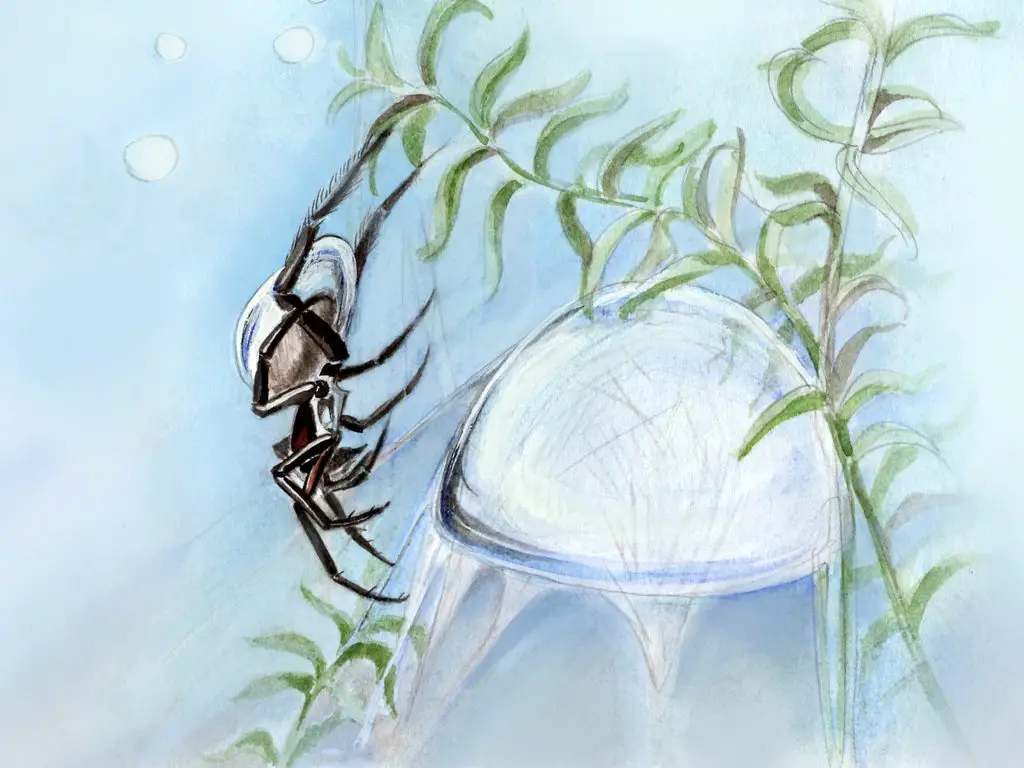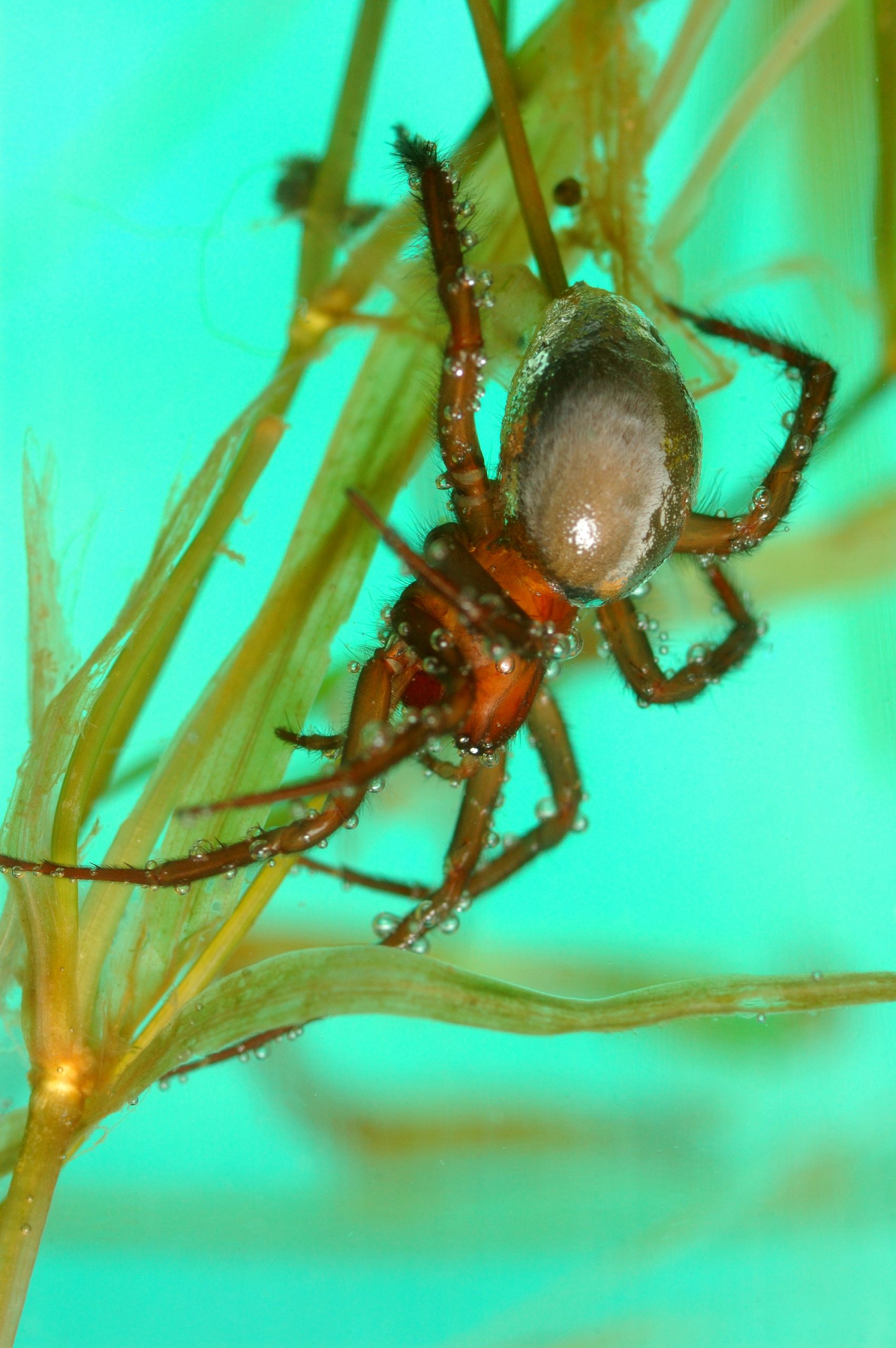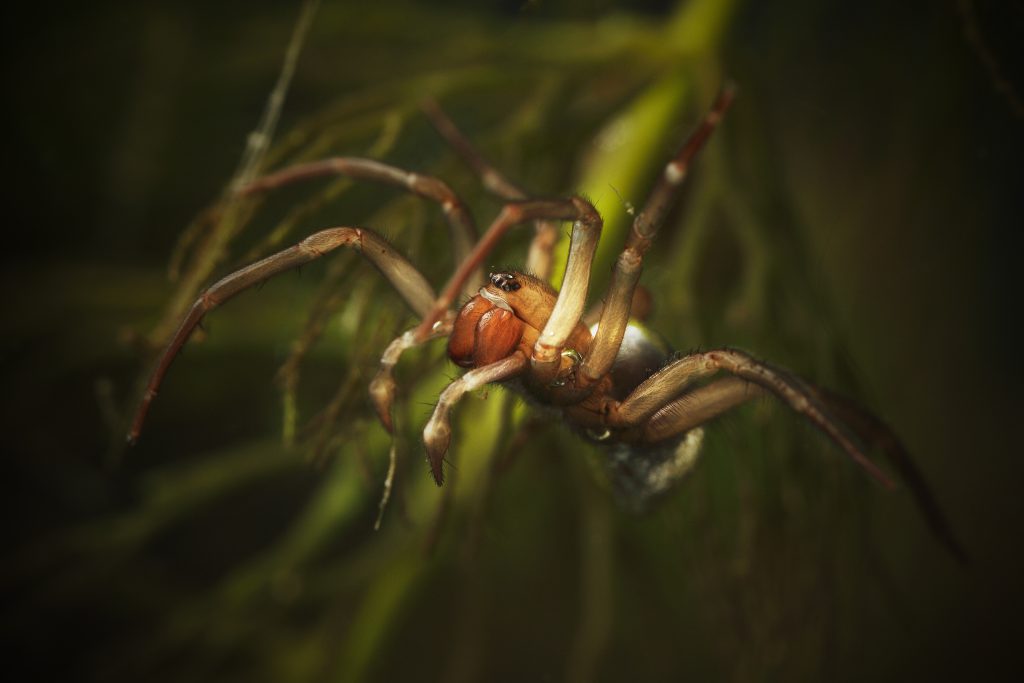Last updated on February 1st, 2023 at 10:06 am
Can Spiders go underwater? Some can, having special adaptations that allow them to do so. The most well-known example being the Diving Bell Spider (Argyroneta aquatica)…
The answer to the question, “Can spiders go underwater?” might surprise you. This article will discuss the techniques these creatures use to breathe underwater. The questions raised will also include where they live, what they eat, and how long they can hold their breath for. Read on to discover the secrets of diving bell spiders! – What is their secret to staying underwater? – And more! – Check out the video below!
How does the diving bell spider breathe underwater
How does the diving bell spider breathe underwater? Well, it builds itself an underwater air bubble, held in place by webbing. This acts as a reservoir of air for it to breather while living down there.
When it needs more air, it goes to the surface, and traps it on the hairs of its abdomen before bringing it down to replenish its air bubble lair. Pretty smart when you think about it!
The spider breathes air from the bubble – called a diving bell – and then exhales carbon dioxide, which dissipates rapidly into the water. Consequently, the spider would take up oxygen from the water and expel carbon dioxide, but not enough to meet its metabolic needs. In fact, studies have shown that the spider constantly adds air from the surface of the water to its bell.
The bell of the diving bell spider is similar to the top of a deep umbrella. The bell of the spider is its home, and where it rests when not hunting. In this way, the diving bell spider remains hidden and safe from predators.
The spider’s distinctive air bubble that it traps on its abdomen is enough to survive when swimming. It uses this air bubble to breathe, and its metabolic rate is similar to that of other spiders waiting for prey.

How long can spiders hold their breath underwater?
Generally speaking, even Diving Bell spiders come up to the surface at least once a day. However, some species of spider can stay under the water for more than 24 hours without replenishing their air supply.
This ability is the result of their body hairs capturing and exchanging oxygen and carbon dioxide with the water. It allows them to stay below the water’s surface for longer periods and remain out of the way of predators.
Spiders have the ability to stay underwater for long periods, and the secret is in the way they maintain a shield of air around their body. It isn’t the only adaptation they use, however. Some spiders actually go into a state of suspended animation (deep torpor) to avoid drowning.
While spiders prefer not to swim, they can still hold their breath in a variety of situations. Water, especially sewers, can be very oxygen-deficient, and they struggle to survive.
While the common house spider is not a great swimmer, it can survive without oxygen for hours. In some cases, even regular garden spiders may be able to hold their breath for up to three hours under water.
Where does the diving bell spider live?
This spider is unique among arachnids because it lives in water. It feeds on air bubbles and reproduces in the bells of females. The diving bell spider lives in areas of deep water and is not likely to be spotted on land.
However, it is possible to see it while you are underwater, if you’re lucky. It seems to prefer clean ponds with relatively clear water.
Although it is not dangerous to humans, its bite can cause localized pain and a mild fever. The diving bell spider is able to live up to 24 hours without surfacing, which can make it very hard to observe or even locate.
To determine where the diving bell spider lives, scientists collect them in the wild. So far, they have been recorded in almost all of mainland Europe, and all the way accross Asia, as far north as Siberia. One subspecies, A. a. japonica, is even found in Japan.

What do diving bell spiders eat?
If you’ve ever wondered what diving bell spiders eat underwater, then you’re not alone. In fact, researchers have been examining this phenomenon for decades.
They’ve found that they consume aquatic prey such as water fleas (Daphnia), insect larvae and small crustaceans like amphipods. For some reason, the spiders occasionally catch their prey underwater but bring it to the surface to feed. Why they do this isn’t entirely clear.
Why does the diving bell spider live underwater?
The diving bell spider lives almost entirely underwater, where it conducts most of its life. It can breathe underwater by producing a bubble, which functions like its lung in the water. While this may sound scary to you, this spider isn’t at all scary.
Instead, its underwater life has a unique purpose.
The diving bell spider lives in a silk sheet that resembles a deep umbrella. The spider lives in these bells and reproduces inside them. They spend most of their time underwater, so you’ll never see one on land.
In order to breathe in water, diving bell spiders use their gill-like structure to harvest oxygen from the water. While the atmosphere is 78 percent nitrogen, water contains 21 percent oxygen. Because oxygen dissolves more readily in water than nitrogen, the diving bell spider can breathe in air with a concentration of 35 percent. By forming a bubble, the air in the water bubbles are able to absorb oxygen from the water. This allows the spider to stay underwater for more than 24 hours at a time.
Doing this allows them to avoid land predators almost completely. It also allows them to avoid competition with other spiders. Though not of people know it – one the main predators of spiders is other spiders!

Diving bell spider size
The average size of a male Diving Bell Spider is approximately 10-15 mm. This is slightly smaller for females are usually only up to 12mm. Because the male is larger than the female, this makes him more mobile when it comes to searching for a mate.
Both sexes have large bells, but the females spend more time maintaining the large bell to use it for a place to lay eggs.
Male water spiders build a diving bell next to the female and spin a tunnel to reach the bell. The female then lays about 30 to 70 eggs in the bell, maintaining the bell to ensure that the eggs survive. Young water spiders do not construct a bell immediately.
They do this after they have completed their first moulting cycle. They will eventually build their own bells and move away from their mother.
Do you get water spiders in the UK?
British residents may be curious about the presence of water spiders. While spiders generally do not mix with water, they have adapted to life in water in the UK. A clean, natural pond, for example, is a perfect place to look for a Diving Bell Spider.
In all honesty, Diving Bell Spiders can be extremely hard to find. It’s definitely worth looking for them though, because whilst searching you could find the UK’s other water loving arachnid: the Fen Raft Spider.
Fen raft spiders are also known as water spiders. They are medium-sized and harmless to humans. These spiders were nearly extinct ten years ago, but they are now widespread throughout the U.K.
The RSPB has estimated that there are thousands of Fen raft spiders living in the UK. The female spiders are known to carry their offspring on their back.






